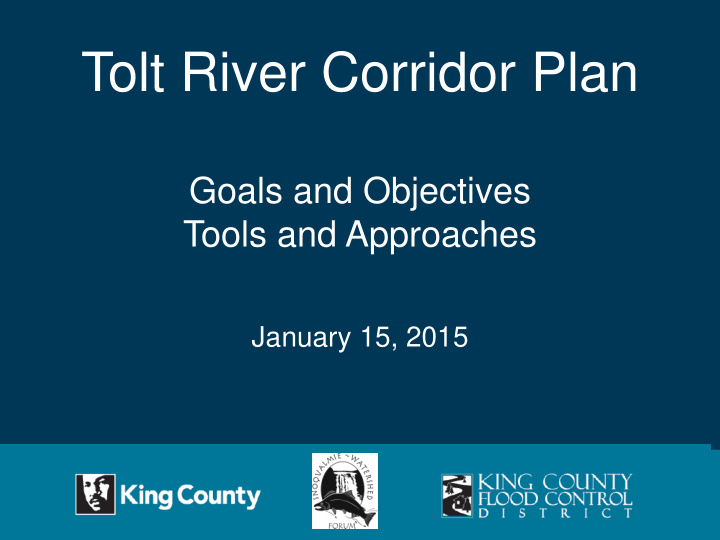



Tolt River Corridor Plan Goals and Objectives Tools and Approaches January 15, 2015
Goals and Provisional Objectives Goal 1 Reduce risks from flood and channel migration hazards Consider future sediment accumulation and climate change Reduce levee breach hazards Mitigate risks from channel migration and avulsion hazards Consider risks over a long time horizon
Goals and Provisional Objectives Goal 2 Reduce long-term costs of flood hazard management Implement sustainable solutions Reduce facility maintenance and repair costs
Goals and Provisional Objectives Goal 3 Improve salmonid habitat and restore natural river processes Protect and improve floodplain habitats and off-channel connections Protect and improve instream aquatic habitat Protect and improve riparian habitat
Goals and Provisional Objectives Goal 4 Incorporate stakeholder and community input into the Corridor Planning process. Involve the community and stakeholders and incorporate their input Provide equitable outcomes to all in the community
Floodplain management tools Levee setbacks Maintain and repair existing levees and revetments Home buyouts and open space acquisition Remove existing levees and Levee Setback revetments Raise or reconstruct levees and revetments in their current location Home Buyout
Floodplain management tools Bridge and road modifications Gravel removal Land use management New in-stream wood structures Wood Structures Bridge Improvement
Possible Corridor Approaches Approach 1: Encourage natural river processes Levee setbacks, extensive home buyouts in most hazardous areas Allow the river to naturally store and convey flood waters and sediment Approach 2: Prevent flooding and channel migration to the extent feasible Rebuild levees and roads in their current locations to higher standards Limit natural flooding processes Approach 3: Continue existing management practices Repair damages after they occur, make limited improvements
Approach 1. Encouraging natural river processes: levee setbacks More room for floodwaters Setback levee and sediment
Approach 1. Encouraging natural river processes: home buyouts in hazardous areas San Souci neighborhood Jan. 2009
Approach 1. Encouraging natural river processes Advantages Drawbacks Highest certainty of Highest initial costs reducing risks Requires extensive real Works with the river rather estate including buyouts of than against it residences Lower maintenance costs Significantly improves river habitat
Approach 2. Prevent flooding and channel migration: Higher levees, structural solutions Example of levee reconstruction adjacent to river (Green River)
Approach 2. Preventing flooding and channel migration Advantages Drawbacks Reduces risks for residences Upstream and downstream and roads impacts Preserves existing housing Expensive to construct and and maintains current road maintain locations Further degrades habitat conditions Difficult to permit
Approach 3. Continue Existing Management Practices Repair damages after they occur Make limited improvements Tolt River emergency repair Jan. 2009
Approach 3. Continue existing management practices Advantages Drawbacks Low cost to implement Maintains substandard flood risk conditions Smaller, simpler projects Increasing risk in future Easier to design and permit Increasing long-term costs Most predictable to as facilities degrade community (least change) Further degrades habitat conditions
Questions & Discussion Do these initial goals make sense? Which actions do you support? Which do you not support? Is there anything else you’d like to share?
Recommend
More recommend